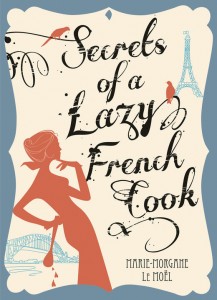 “Il faut qu’on parle en français,” Monsieur P greets me with at St Leonards Station, handing over an armful of fresh posters and flyers for our show Parisian Rendez Vous. We’re on the way to SBS for an interview in French and having been away from the Continent since October, he’s slightly nervous he’ll forget how to finish a sentence.
“Il faut qu’on parle en français,” Monsieur P greets me with at St Leonards Station, handing over an armful of fresh posters and flyers for our show Parisian Rendez Vous. We’re on the way to SBS for an interview in French and having been away from the Continent since October, he’s slightly nervous he’ll forget how to finish a sentence.
“Ok mais ça va aller,” I reassure him, I spoke with the journalist Marie on the phone yesterday and she was really lovely and easy to talk with. “Vraiment?” he relaxes and pulls out the lyrics to ‘Sympathique’ that we plan to perform live to air after the interview.
A short drive and an impressively long (half hour) interview later, Monsieur P is all smiles. “It’s so good to be given the space and room to talk about it,” he gushes. With Marie, the polite and perky journalist from the East of France, we’d been in good hands. She knew how to balance space with direction and understood the concerns and desires of an operatic, acrobatic, vaudevillian singer… and had won him (and me) over.
“How do you know the Basement?” I ask. “Jane (Burridge) is the agent for my book.” Oh? “It’s sort of like Almost French but the other way around,” she says (in French) then modestly changes the topic back to our show.
Two days later, the post delivers a brown package. I love brown packages so it was a good start. Inside is a paperback with a design of the Eiffel tower on top right of the cover and the Sydney harbour bridge on the bottom left, above which is a red silhouette of a chic woman holding a cooking spoon dripping with three small, upside-down hearts. A rosella and a pigeon look at each other, perched on the inky title font reading “Secrets of a Lazy French Cook”.
The book is an autobiography of sorts through the traditional French dishes that Marie has learnt to whip up over the years with tips from her mother ‘Madeline’. As the cover suggests, it begins in France (with quirky childhood antics, tied to easy to follow traditional French recipes for example ‘mouse au chocolate facile- easy to make chocolate mouse’) and finishes in Sydney (where she gets carried away with cooking croque monsieurs to appease homesickness between journalistic assignments and falls in love). Along the way we experience her university mussels dishes she uses to (try to) win hearts, French cheese highs while interning in freezing Montreal and other adventures of the heart and soul leading to the necessary, almost medicinal, preparation and consumption of truffles, red and white fish terrine (terrine de deux poissons), ratatouille and blanquette de veau facile (creamy veal stew- again- the easy way).
Marie’s interpretation of her persona as a direct, idiosyncratic and intrigued child, teenager and woman is charming. While I’m initially sceptical of the humour in the foreward, by the end of Chapter One I am hooked and whizz through the stories with many a smile and chuckle. It’s a buoyant read. As for the recipes, while a couple feel a little tenuously linked to stories, it doesn’t really matter as the premise works- and with French culture and identity is so entwined in food, the mix of stories and recipes is fitting.
Why not take take your time with the book and make your way through each recipe, written in a relaxed tone with playful asides. Marie’s take on French cuisine is just that- dishes don’t need to be complex to cook- just the life and love that surround them are. Deliciously complex.
Marie couldn’t come to The Basement to see Parisian Rendez Vous as was flying back to France to cover the elections- which I guess is a reasonable excuse- but will remain in France for all of May. And while she has a half hour knowledge of part of my life, I suddenly feel I know her intimately. So I have asked if she’d like to meet up in Paris where I’ll return next week. Over email she has agreed enthusiastically asking to come to the next Paris Tap Jam. I’ve said yes and will soon break the news that it’s on the terms that she shows me how to cook a lazy French dish in person. Perhaps I’ll invite a film crew- so stay tuned. In the meantime, you can buy Secrets of a Lazy French cook here. I’m about to try a quatre-quarts gateaux.
The quatre-quarts Cake (excerpt form Secrets of a Lazy French Cook)
(with apples)
The quatre-quarts cake takes its name from the way it is prepared.
You’ll need ‘four fourths’: four ingredients will form the dough. And all of them are supposed to have the same weight. The quatre-quarts, being so easy to prepare, is a classic of French country cuisine, and you can diversify it in many ways.
WHAT YOU NEED (serves 6)
3 eggs
200 g caster sugar
200 g unsalted butter (the true cook would have you weigh the eggs first on a scale, and then use the same amount of every other ingredient. But the lazy chef doesn’t own a proper scale, of course).
200 g self-raising flour
2-3 apples
WHAT TO DO WITH YOUR HANDS
1. Preheat the oven to 180°C.
2. In a large bowl, beat the eggs. Beat well until they become fluffy.
3. Add the sugar. Mix well.
4. Add the butter, which you’ve melted beforehand. Mix well.
5. Gently add the flour, a little at a time.
6. Peel and core the apples, then slice and add to the mixture just before you put your cake in the oven (this is optional, you can prepare your cake without apples).
7. Once it’s done, pour into a cake tin.
8. Put in the oven for 45 minutes (this is an indication only, so check regularly).
MADELEINE’S TIPS
Some true cooks will prefer to whisk the egg whites and add them to the mixture at the end, after the flour. It will give the cake a lighter taste.
To flavour your cake, you can add orange or lemon zest, or vanilla extract. You can also add chocolate chips.
WHAT TO DRINK: Cider.
(PS Ruby’s Tip- keep book slightly removed from the action. My new paperback now has smears of sugary yellow cake mix on it! But the kitchen is smelling great.)


